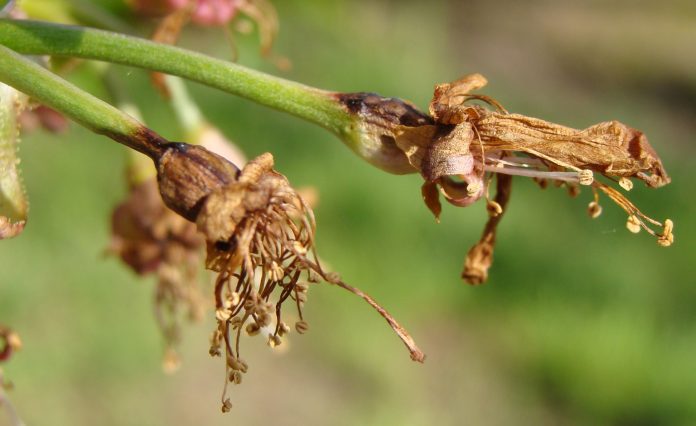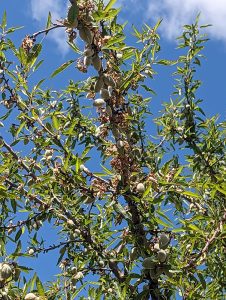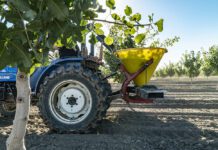
Weather played havoc on the 2023 almond crop. Cold, high rainfall and even snow in parts of the state created problems for growers and set the stage for widespread bacterial blast.
Jim Adaskaveg, professor and plant pathologist at UC Riverside, said, bacterial blast in almonds was widespread in the Central Valley.
Bacterial blast depends on how cold it gets. Places where temperatures reached 28 degrees F and frost occurred are perfect for blast, Adaskaveg said.
Blast in the South
Mohammad Yaghmour, orchard systems advisor for Kern County, said conditions in the south were very wet but lacked the conducive environmental conditions that would have brought on bacterial blast during almond bloom.
“We only saw very small incidents of bacterial blast on sweet cherries,” Yaghmour said.
However, the continuous rain during almond bloom and thereafter resulted in significant blossom and jacket rot. “We have seen blossom rot caused by Monilinia fructicola, and we saw jacket rot too caused by Monilinia or Botrytis. In certain cases, we found both pathogens at the same time,” Yaghmour said.
The wet weather also made it difficult for growers to get into the orchard and make spray applications, he continued. “Some orchards, especially certain varieties like Wood Colony and Butte, had significant damage,” Yaghmour said.
Some growers did manage to make aerial applications, but weather made that difficult too. “We had quite a bit of rain all the way from bloom through spring, so pretty much the growers did not have a break.”
Yaghmour didn’t see much damage on the Nonpareil, but orchards that have Wood Colony as a pollinizer, had a significantly high incidence of disease.
Harvest is running late in the southern part of the state by about 10 days to two weeks, so it’s still too early to determine the full level of damage.
Kasumin
Many growers used Kasumin (kasugamycin) this year to manage blast in their orchards. “There were various reports that some people said it worked and some people said it didn’t work,” Adaskaveg said.
Performance is dependent on several things: application timing, application rates and application volume. This could account for the wide range of responses Adaskaveg received.
Bactericides aren’t like the newer fungicides that provide 100% control. For example, some of the newer fungicides used for brown rot blossom blight eliminate the disease. With bacterial diseases, whether it’s fire blight, walnut blight or bacterial blast, there are significant reductions, but never 100% control. Growers still see blast even when they’ve sprayed and think it wasn’t controlled, but in reality it did work, Adaskaveg said.
“We have had multiple trials where there are untreated controls that have had high incidence of blast, and the Kasumin treatment significantly reduced [but not eliminated] the disease.”
Copper
Copper has been the treatment of choice for decades, but the Pseudomonas syringae pathogen is well known to have copper resistance in certain populations.
“How widespread is copper resistance? It’s pretty common, but it’s not everywhere. Some growers report they got benefits using copper, but most growers report that there were no benefits,” Adaskaveg said, adding that he hasn’t seen benefits in his research.
Some growers are applying mancozeb with copper, and that combination also has some benefits, he continued. Mancozeb is approved in almonds, and it’s used in combination with copper, which is effective against all kinds of bacteria.
“There is benefit to it, but I don’t think it’s as widespread a benefit as we would hope it to be,” Adaskaveg said, and he reminds growers mixing with mancozeb increases costs and copper can cause phytotoxicity to leaves.
In Adaskaveg’s trials, he’s seen benefits with copper/mancozeb, but kasugamycin was more beneficial against bacterial blast. None of these treatments resulted in zero levels of disease, he stressed.
“That’s the problem; I think people expect a lot because their fungicide sprays really work well, and they think bactericides should work as effectively,” Adaskaveg said.
Jaime Ott, UCCE orchard systems advisor for Tehama, Glenn, Butte and Shasta counties, said, “Cold and wet is what usually triggers blast, and we were expecting to see a really big problem with it this year. We had cold weather, we had the snow, we had the freezing temperatures, we had the wetness, and so we were quite surprised that we didn’t see a bigger problem with bacterial blast in the flowers.”
To Ott’s surprise, blast damage showed up in the spring when it killed leaf bundles. The leaf defoliation looked awful, and growers were worried about it, but in reality those leaf bundles fell off and were replaced by new leaves, she said. “It probably didn’t have much effect.”

Most North state growers didn’t spray kasugamycin because it’s expensive, and very few were even able to spray because of the weather, Ott said.
“We did have some growers that were spraying copper,” she continued. “But this is really important and something I really try to stress to people: We have so much copper resistance in Pseudomonas syringae that even if you’ve sprayed copper, if you saw symptoms, you probably had a resistant population.
“Growers spray copper and then feel confident that they are protected, and I think that is not the case. Those bacteria, they’re good at doing what they do. They’re good at evolving.
“Copper is used because it’s less expensive, but it is also decidedly less effective,” Ott said, adding resistance is so common that it’s hard to encourage growers to use copper.
Cankers
Bacterial blast damages the flowers, leaves and shoots, but it can also cause cankers on the tree. “This is when it gets into the branches and trunks,” Adaskaveg said, adding it’s thought to get in when there’s cold damage or the trees are stressed from other injuries such as nematode root damage.
When it warms up in the spring, canker symptoms such as gumming around the affected tissue will begin to form on the trunk. It’s the same organism but a different phase, so it’s called bacterial canker, Adaskaveg said.
This bacterium is epiphytic, meaning it lives on plant surfaces, and if the conditions are favorable, it will invade the host tissue. “Usually, the canker phase is more related to root stress, water-stressed roots or damaged roots from nematodes, these types of stresses,” Adaskaveg said.

Spraying helps reduce the inoculum so the pathogen can’t invade the injured tissue. Still, if it is too cold, the tissue will die, but it doesn’t form a canker, doesn’t cause a blasted flower, and the flower may freeze and abort if it gets down to 26 degrees F or below. With application of a bactericide, there’s no pathogen present to cause the disease, but with extreme cold, there is still flower death, Adaskaveg said. This is another possible explanation for variable results observed this past spring with the use of Kasumin.
Damage
Some areas reported crop loss from bacterial blast, but Adaskaveg hasn’t received details of how and when chemicals were applied. For the best results with kasugamycin, it needs to be applied within a week before the frost event. So, for example, if a frost event is predicted for next Monday, it should be applied Wednesday, Thursday or Friday of the current week, he said.
Bactericides like kasugamycin have what is termed a diminishing effect, meaning they don’t have great residual activity. They usually have just a few days, which is why it must be applied right before a freeze event.
“These are the challenges because these types of compounds degrade by sunlight, wetness and other environmental factors” Adaskaveg said.
If an application of kasugamycin was made, and the freeze event came 10 days later, it would be less effective. This is a big problem for growers trying to make effective applications because the bactericides are designed not to persist, and that means they have a short residual lifespan, Adaskaveg said.
Section 18
Adaskaveg applied for an Emergency Registration (Section 18) for Kasumin for the 2023 season. “It’s very frustrating on my end because the EPA was supposed to rule on this three years ago for the full registration (Section 3), but they keep changing the PRIA (Pesticide Registration Improvement Extension Act) date,” he said.
The law that says the EPA has to act by a specified date is circumvented because they found a loophole in the law where they can change the date. “We’ve been through at least four or five of these PRIA date changes that have been six months at a time,” Adaskaveg said. Unfortunately, the EPA is postponing registrations of several new pesticides due to their efforts to consider the Endangered Species Act (ESA) for many existing registrations and the lack of personnel at the agency because of retirements during COVID-19 in 2020-22.
Adaskaveg is planning to apply for another Section 18 for Kasumin for the 2024 spring season. “They told me that if you want it, you just have to keep applying for a Section 18, which is very disappointing,” he said, adding it’s a time-consuming process that takes three to four months of review before receiving approval.











